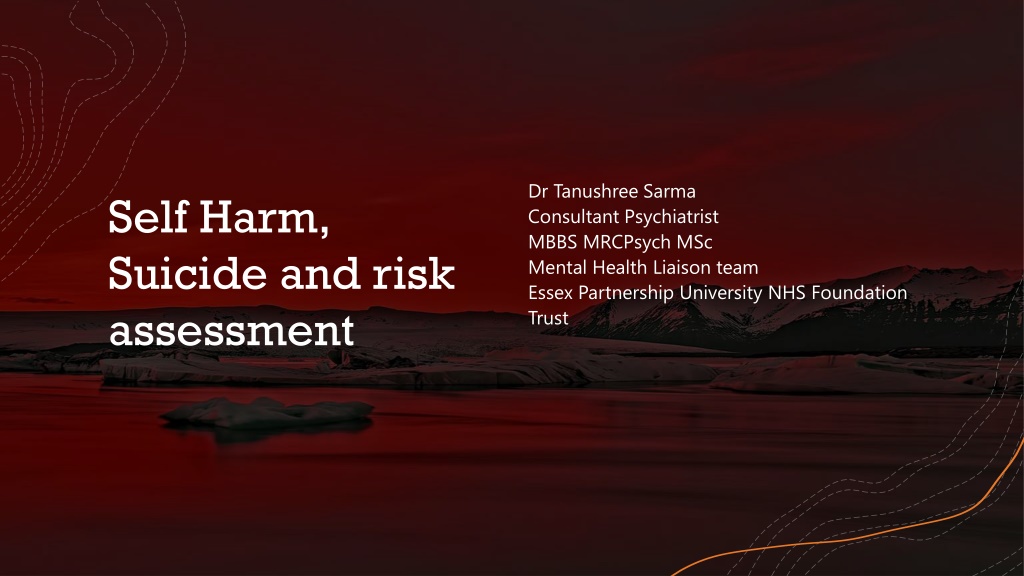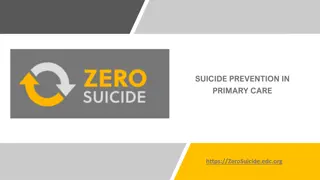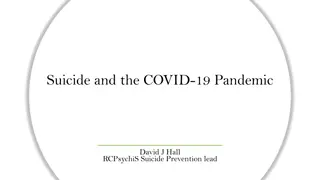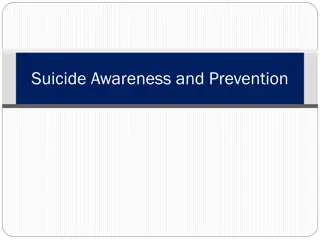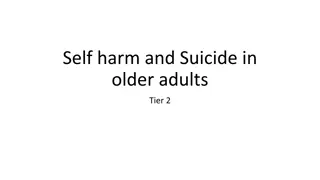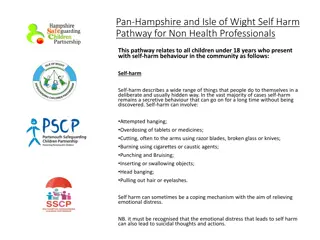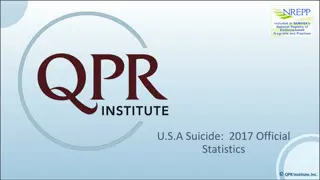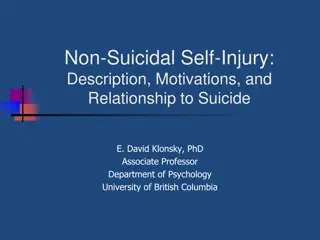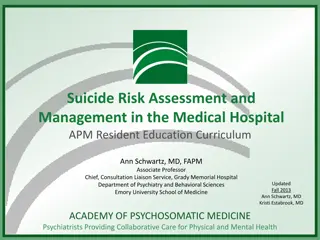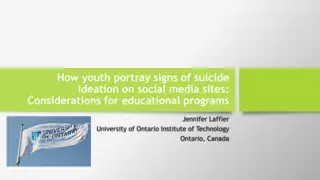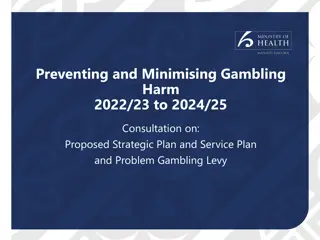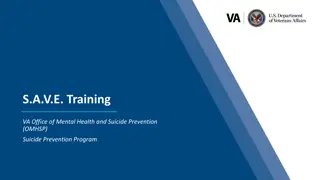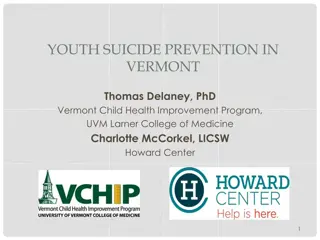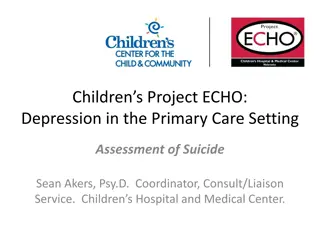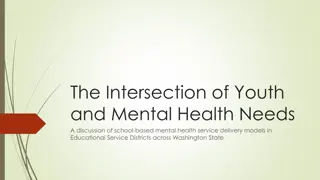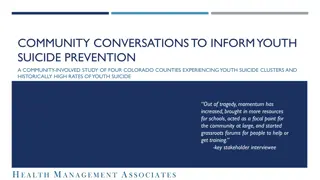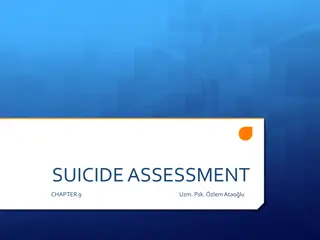Understanding Suicide and Self-Harm: Statistics and Causes
In the UK, suicide rates, especially among young women and certain high-risk groups, have been increasing. Understanding the prevalence of self-harm and suicidal behaviors, as well as the key causes such as depression and bipolar disorder, is crucial for effective prevention and intervention strategies.
Download Presentation

Please find below an Image/Link to download the presentation.
The content on the website is provided AS IS for your information and personal use only. It may not be sold, licensed, or shared on other websites without obtaining consent from the author. Download presentation by click this link. If you encounter any issues during the download, it is possible that the publisher has removed the file from their server.
E N D
Presentation Transcript
Dr Tanushree Sarma Consultant Psychiatrist MBBS MRCPsych MSc Mental Health Liaison team Essex Partnership University NHS Foundation Trust Self Harm, Suicide and risk assessment
Statistics ( Acute Psychiatric Morbidity survey) + One in four 16 to 24 year old women (25.7%) reported having self-harmed at some point compared to 9.7% for men in this age group and women aged 25 to 34 (13.2%). The gap between young men and young women has grown over time. + The proportion of the population who reported having self-harmed increased from 2.4% of 16 to 74 year olds in 2000 to 6.4% in 2014. This increase is evident in both men and women and across age-groups. Greater awareness of self-harming is probably a factor in the increased reporting. + Some groups in the population are more likely than others to report suicidal thoughts and behaviours. Benefit status identified people at particularly high risk: two-thirds of Employment and Support Allowance (ESA) recipients had suicidal thoughts (66.4%) and approaching half (43.2%) had made a suicide attempt at some point. + Overall, half of people who attempted suicide sought help after their most recent attempt (50.1%). About a quarter sought help from a GP, a quarter went to a hospital or specialist medical or psychiatric service, and a fifth tried to get help from friends or family.
Suicide (Office for national statistics) + In the UK in 2018, there were 6,507 deaths by suicide (a rate of 11.2 deaths per 100,000 people). + In 2019, there were 5,691 suicides registered in England and Wales, an age-standardised rate of 11.0 deaths per 100,000 population and consistent with the rate in 2018. + Overall, men accounted for three-quarters of UK deaths by suicide in both 2018 and 2019. + Males aged 45 to 49 years had the highest age-specific suicide rate (25.5 deaths per 100,000 males); for females, the age group with the highest rate was 50 to 54 years at 7.4 deaths per 100,000. + As seen in previous years, the most common method of suicide in England and Wales was hanging, accounting for 61.7% of all suicides among males and 46.7% of all suicides among females.
Causes of suicidal behaviour + Over 90 % of suicides occur in the context of Psychiatric disorder + Depression - + Highest risk when recovering from a Severe episode ( 2 core plus 4 other symptoms at least) + Core symptoms Depressed mood, Anhedonia, Reduced energy / increased fatigue + Other symptoms Reduced concentration, self esteem, ideas of guilt and unworthiness, bleak and pessimistic views of the future, suicidal ideation + Somatic symptoms insomnia, early morning awakening, diurnal variation of mood, reduced appetite, weight loss, loss of libido, psychomotor retardation + Also high risk, if 4 or more past episodes of depression, and history of hospital admission + Comorbid psychiatric disorders like ADHD, anxiety disorders, PTSD etc + Bipolar disorder + the lifetime risk for suicidal ideation is significantly greater in patients with bipolar disorder vs major depressive disorder (29.2% vs 17.3%), as is the risk of attempted suicide (18.8% vs 4.78%) and suicide (1.73% vs 0.48%). More common in Bipolar type 1, and more violent methods used than depressive disorder
+ Substance misuse ( drugs and alcohol) increases impulsivity, impaired judgement, disinhibition leading to suicidal tendencies, sometimes accidental overdose. + Alcohol and drug use can also increase risk of fatality due to medical complications + Alcohol and drugs are often co-morbid to trauma and mental illness + Higher likelihood of completed suicide due to methods used + Schizophrenia and other psychotic illnesses systematic review found the following increases risks of suicide + previous depressive disorders + previous suicide attempts + drug misuse + agitation or motor restlessness + fear of mental disintegration + poor adherence to treatment + recent loss + Reduced risk was associated with hallucinations + Personality Disorder + Emotionally unstable personality disorder, borderline type (BPD), is the commonest type associated with self harm and suicide + BPD patients have a mean of three lifetime suicide attempts, mostly by overdose + Non suicidal self injury is common in BPD and linked to emotional dysregulation, attempts to alleviate painful emotional states, and addictive cutting. It does not necessarily reflect a wish to die + Some drug overdoses might not be with suicidal intent, which can be determined by quantity of medication taken, if it followed a stressful incident, and help was sought by the patient, when treatment could still reverse the effects of overdose. These patients would show an ambivalent motivation to self harm, often saying they wished to escape their circumstances, than wishing to die.
Other risk factors + Early life trauma ( childhood maltreatment) + Family History of Suicide + Previous Suicide attempt + Feelings of hopelessness, helplessness, worthlessness + Physical illness which include medical conditions like . And chronic pain + Male + Impulsivity and aggression + Social isolation + Unemployment and low socio economic status + Loss ( death of loved one, loss of work, financial) + Being exposed to other people s suicidal behaviour, example celebrity, family or friend
Factors indictaing high risk + Act carried out in isolation + Precautions taken to avoid discovery + Pre planning making a will, insurance, getting affairs in order + Preparation for the act hoarding tablets, buying from multiple pharmacies, purchasing rope etc + Seriousness of the attempt example large number of tablets, violent method + Not being under the influence of alcohol or drugs, which indicates premeditated, and not impulsive + Suicide notes + Not alerting anyone after the act + Becks cognitive triad Negative views about the world, about oneself and about the future
Information to put in a mental health referral Current biological symptoms Any ongoing stressors Past psychiatric history plus psychotropic medication history Medical illnesses including medications Substance misuse ( current mainly) Risk
Management of suicide risk +Management of the core psychiatric disorder +Antidepressants/ Mood stabiliser/ antipsychotics +CBT/ Mindfulness/CAT for depression, anxiety +EMDR for PTSD +DBT/ Schema focussed therapy/ CAT for Personality disorders +Safety planning limiting access to means of self harm, having a crisis plan that includes coping strategies, and people that can help when in crisis +SIM project for frequent self harmers with a diagnosis of personality disorder
Case studies +38 year old woman in A & E, brought by her husband who says she has been very depressed for the last few days, but prior to that she was feeling very well, and in fact hardly sleeping at all, being overtalkative and loud, and very active. +8 week pregnant lady with known history of depression, presenting with low mood and tearfulness +22 year old lady presenting with self harm and thoughts of suicide, with previous history of self harm and eating disorder +48 year old man attends A & E feeling suicidal. He has recently lost his job, which has led to a breakdown in relationship. He admits to using alcohol and cannabis to cope. +72 year old man presents to A & E following an overdose, but no previous history of mental illness. Trigger is his wife s recent death
